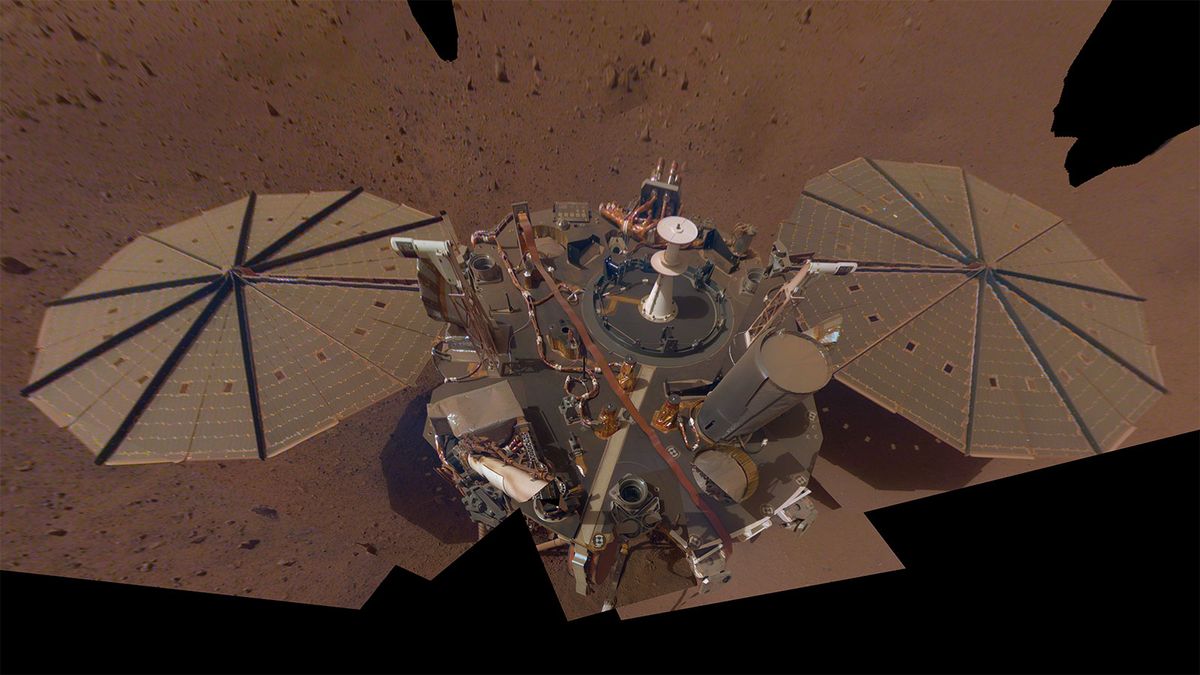
The magnetic field in one zone on Mars is about 10 times stronger than scientists expected, and it's changing rapidly.
New data gathered from NASA's InSight lander , which has been on the Red Planet for a little over a year now, shows that the planet's magnetic field fluctuates rapidly . InSight is the first landing mission to carry a magnetic sensor, which allows it to measure these fields from up close.
"The ground-level data give us a much more sensitive picture of magnetization over smaller areas, and where it's coming from," lead author Catherine Johnson, a professor at the University of British Columbia and senior scientist at the Planetary Science Institute, said in a statement . "In addition to showing that the magnetic field at the landing site was ten times stronger than the satellites anticipated, the data implied it was coming from nearby sources."
In case you are keeping track:
Mars is a seismically active world, first results from NASA's InSight lander reveal | Space

The first official science results from NASA's quake-hunting InSight Mars lander just came out, and they reveal a regularly roiled world.
"We've finally, for the first time, established that Mars is a seismically active planet," InSight principal investigator Bruce Banerdt, of NASA's Jet Propulsion Laboratory (JPL) in Pasadena, California, said during a teleconference with reporters Thursday (Feb. 20).
* * *
"In fact, it's probably close to the kind of seismic activity you would expect to find away from the [tectonic] plate boundaries on Earth and away from highly deformed areas," he said.
Study of Crater Shows How Mars Could Have Hosted Oceans | Digital Trends

Lyons and his team wanted to know how it was possible for Mars to have had water on its surface in the past , as it is further from the sun than Earth is and at the time the sun would not have given out that much heat. "To have made the planet warm enough for liquid surface water, its atmosphere would likely have needed an immense amount of greenhouse gas, carbon dioxide specifically," explained Chris Tino, a UCR graduate student and co-first author of the paper.
There’s no way to measure the amount of carbon dioxide that was historically in the Martian atmosphere, so the team looked for an analog here on Earth. They found the Nordlinger Ries crater in Germany, which was formed when a meteorite hit the Earth 15 million years ago. They studied this crater and found the water it had contained had a high pH level and high alkalinity, a combination that could allow microorganisms to survive.
Why Mars Needs Leap Days, Too - The New York Times

This Saturday, you have the gift of time. Feb. 29 is a leap day — a calendar oddity that gives us an extra day.
You probably know why: The time it takes Earth to rotate on its axis is called a day — but it doesn't take an even number of days to complete a single loop around the sun, or one orbit. Instead it takes a messy 365.2422 spins. And yet the calendar year runs out after 365 days. That means that when the clock strikes midnight on New Year's Eve, Earth hasn't quite circled all the way back to its starting point.
Other things to check out:
Japan to launch a sample-return mission to Mars moon Phobos in 2024 | Space

The Martian Moon Exploration (MMX) mission, which aims to haul pieces of the Mars moon Phobos to Earth, has officially become a Japan Aerospace Exploration Agency (JAXA) project, mission team members announced on Thursday (Feb. 20).
"The mission was previously in the pre-project phase, where the focus was on research and analysis, such as simulating landings to improve spacecraft design," MMX team members wrote in a blog post . "The focus will now move onto the development of mission hardware and software."
Star freshman Rodney Gallagher leads Laurel Highlands past Mars in WPIAL Class 5A thriller - Trib

Laurel Highlands’ Rodney Gallagher celebrates after defeating Mars in the WPIAL Class 5A championship game Friday, Feb. 28, 2020, at Petersen Events Center.
Laurel Highlands captains carry the championship trophy from the court after defeating Mars in the WPIAL Class 5A championship game Friday, Feb. 28, 2020, at Petersen Events Center.
Laurel Highlands’ Rodney Gallagher sinks the winning free throw in the final seconds of the WPIAL Class 5A championship game against Mars Friday, Feb. 28, 2020, at Petersen Events Center.
Cornell Project Team Practices for Mars Exploration | The Cornell Daily Sun

The 30-member team focuses on designing a rover that can assist humans with research on Mars by completing specifically programmed missions, testing their work in annual competitions against other college teams. Mimicking a real Mars mission, team members can only see what is happening through cameras that communicate with the base station via radio.
According to the group's website , "each team must design, build, and operate a rover to compete against other contending universities in a variety of field tasks that actual Mars rovers face on missions to the Red Planet," at the University Rover Challenge, with the winning team going on a trip to the annual International Mars Society Convention.
Planetology - The exploration of the Moon and Mars continues apace | Science and technology | The

T HIS WEEK has seen the publication of results collected by probes to two heavenly bodies: Chang'e 4 , a Chinese mission to the Moon, and InSight , an American mission to Mars. Chang'e 4 landed in January 2019; InSight arrived the previous November. The Chinese team, bowing to the realities of scientific publishing, have presented their results in Science Advances , an American journal.
Chang'e 4 is China's second successful lunar lander, and the first from any country to touch down intact on the Moon's far side—the part never visible from Earth. Its purpose, other than demonstrating China's technological prowess, is to investigate the geology of Von Kármán crater in the Moon's southern hemisphere. To that end it is fitted with a ground-penetrating radar which can peer many metres down.
Happening on Twitter
The Marsquakes just keep on coming. To date, NASA's InSight lander has cataloged about 450 events, and the frequenc… https://t.co/HmT04XSi47 ScienceNews (from Washington, DC) Sat Feb 29 01:15:00 +0000 2020
Mission complete for @NASAJPL's twin MarCO spacecraft, which traveled all the way to Mars with @NASAInsight & relay… https://t.co/3f655nvzCp NASA Fri Feb 28 01:00:01 +0000 2020

No comments:
Post a Comment